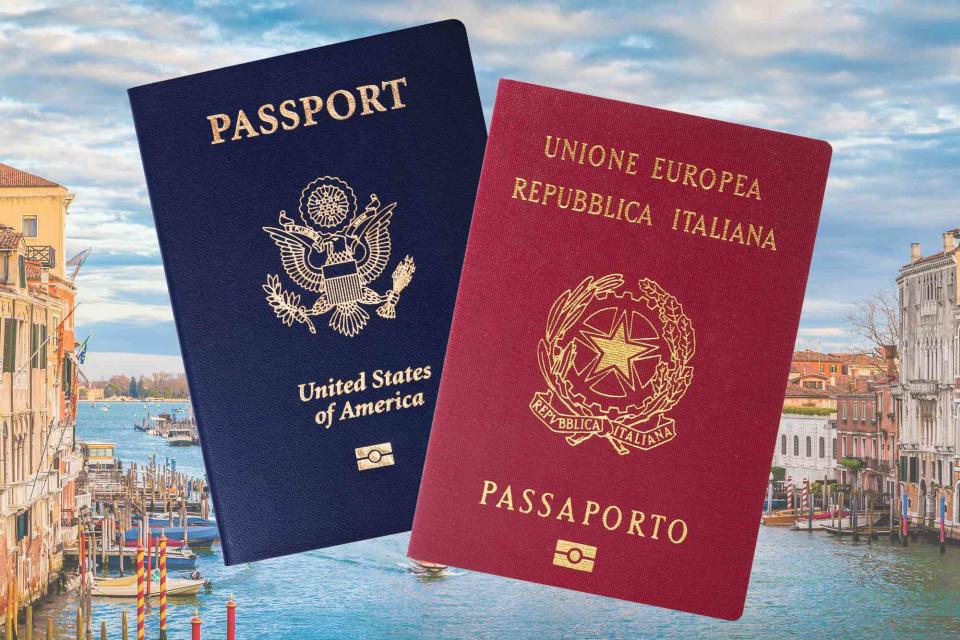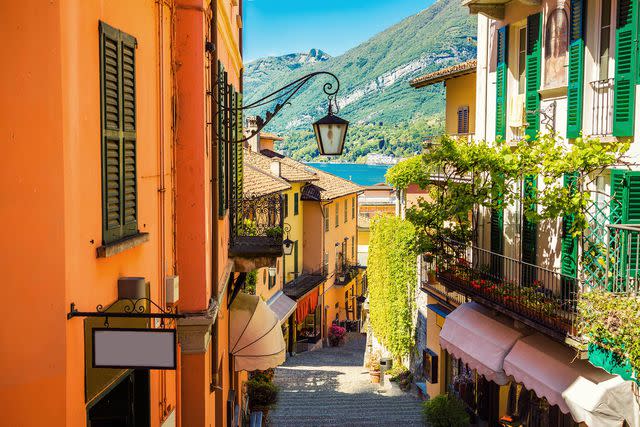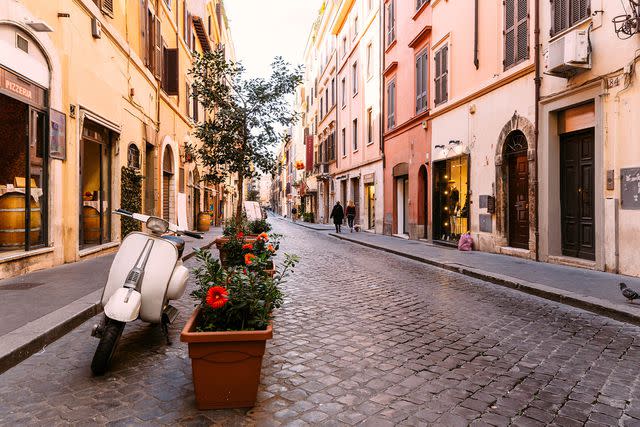I'm Getting Italian Dual Citizenship Through My Family's Ancestry — Here's What the Process Is Like
One traveler shares her journey to claiming dual citizenship.

From left: eldadcarin/Getty Images; MistikaS/Getty Images, Background: Jakob Radlgruber/Getty Images
As the ferry pulled into the dock at Liberty Island, the tourists flowed out to do their lap around Lady Liberty. But I stayed put. The iconic statue was not my destination for the day. Instead, I fixed my gaze on Ellis Island — the place where my journey to Italian citizenship recognition began more than a century ago.
When my great-grandfather crossed the ocean looking for new opportunities, along with millions of other Italians who not only immigrated to the U.S. but also to Brazil and Argentina, he kept his Italian citizenship. He never naturalized, and so by the Italian law of jure sanguinis, he passed the right to claim citizenship on to my grandfather when he was born, who passed this same right on to my father, who then passed this on to me — without any of us ever knowing it.
To pursue dual citizenship, however, I learned I would need to collect every single document marking every major life event between my birth in the 1990s to my great-grandfather’s in the 1880s, a birth that took place, as far as I knew at this point, "somewhere in Italy." Surely, I thought a document that old would have been lost by now, and I dismissed it as "impossible" — until I started meeting people who had actually followed through and gotten their ancestry recognized. It wasn’t impossible, everyone assured me; it’s just a lot of hard work and takes time — that I can confirm is true.
After a year of document hunting and the bureaucratic waiting game, here’s everything I wish I had known when I first learned about Italian dual citizenship.

Michal Ludwiczak/Getty Images
Eligibility
There's no limit to how far back your line can go, but having Italian ancestry does not necessarily mean you are eligible for citizenship recognition. If any of your ancestors naturalized, giving up their Italian citizenship before the birth of the next person in line, the line ends there. This is the keystone question of the process and one of the first things you must confirm before doing anything else.
According to family lore, my great-grandfather never naturalized — a fact I was able to corroborate by searching the records on Ancestry.com and filing a request with the U.S. Citizenship and Immigration Service (USCIS) for an official record of nonexistence to prove it.
This was a simple route, but the process is a bit trickier to prove when your Italian ancestor was a woman, as they were not allowed to pass on citizenship until 1948. You may still be eligible, but your path will be more complicated. There’s a lot of nitty-gritty to get through in the preliminary research phase, but there are resources online. I found helpful fellow citizenship seekers in online communities, but also a lot of conflicting information. A good overview of the eligibility requirements can be found on the official website of the Italian Embassy in the U.S.

Alexander Spatari/Getty Images
How to Find an Italian Birth Certificate
When I first learned I would need to find my great-grandfather’s original birth certificate, I had grand visions of venturing out to my family’s ancestral home in the hills of Basilicata, the high arch of the boot, and knocking on the church door to see if I could thumb through some old records. "No, actually, you can just try to send them an email first," a new Italian friend told me.
With a very roughly translated email, I attempted to contact my great-grandfather’s commune, but my information was too vague. No one could seem to remember his exact birthday or even the year. I waited a few weeks and followed up a few times, but never heard back.
If you begin down the road of claiming Italian citizenship, you will likely encounter the small industry that has popped up in response. Many agencies and services will do a lot of the heavy lifting for you, but it’s not cheap. Some choose to DIY the whole process and save money — as I have tried through most of it — but when it came to finding my great-grandfather’s birth certificate, I knew I would need some help.
I contacted ItalianSide, a company that employs local genealogists in Italy to help track down family histories and find records related to the dual citizenship process. I gave them my great-grandfather’s full name, his town, and a rough idea of when he could have been born. As it turned out, he was one of many Pasquale Ditarantos that had been born in that town. They asked me to provide more information, including whether or not he had any siblings and the year he immigrated.
I returned to the Ellis Island ship manifest, a chaotic list of manic calligraphy that you have to squint to read. On a second look, I noticed something that hadn’t stood out for me before: Four lines above my great-grandfather’s name, there was another Ditaranto from the same town. Did he have a brother? I shared this discovery over email, as well as information about my great-grandmother, who was also born in the same town.
One month later, I had everything I needed and more. Not only did I have a copy of both original birth certificates for my great-grandparents, but I also had copies of their siblings' birth certificates and a full translation that included information like the street they were born on and the names, ages, and occupations of their parents (a.k.a. my great-great-grandparents: two farmers, a tailor, and a spinner).
Entering the Registry Room of the National Immigration Museum, I walked through a space and up to the vintage desks and laminated photocopy of a ship manifest sitting on top. It was somewhere here in the year 1905 where my great-grandfather gave his name in a loud and crowded room of new arrivals. Somewhere up ahead, I imagined an older brother looking back, waiting so they could walk through the door together. In all that chaos, they stayed close enough to sign their names on the same page, and a century later, it has made a difference.
For more Travel & Leisure news, make sure to sign up for our newsletter!
Read the original article on Travel & Leisure.

